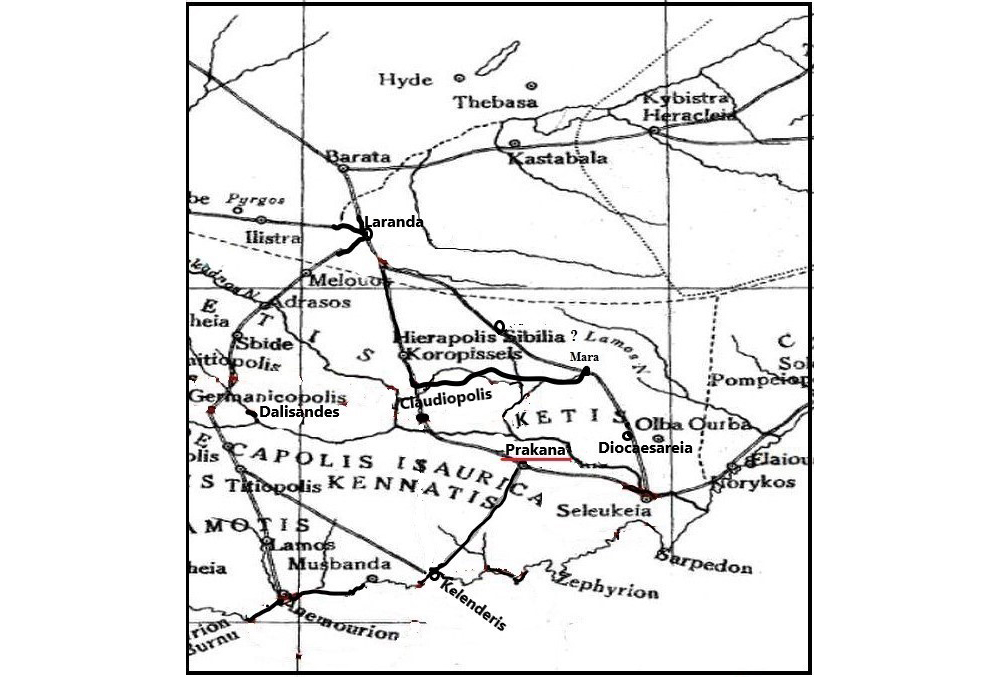Thoughts on the Location of the Ancient Cilician City of Prakana
Ayhan YALÇIN
Abstract
One of the main problems of Ancient Greek and Roman archaeology in Rough Cilicia is that it is not known exactly where some ancient settlements with known names will be located. In this context, it is stated in the ancient sources that the settlement called Prakana is somewhere between the city of Claudiopolis (Mut) and the cities of Seleukeia pros to Kalykadno (Seleucia ad Calycadnum / Silifke). However, apart from this general information, the exact location of the settlement is unknown.
In this article, it is questioned that Prakana was placed in the city of Diocaesareia (today’s Uzuncaburç) with a general acceptance, especially based on what Ramsay wrote in 1890, and that this name was the old name of Diocaesareia. The actual location of Diocaesareia during the years of Ramsay’s writing is not yet known. For this reason, Ramsay takes the narratives in ancient sources as a criterion. In addition, the priest who attended the Second Council of Nicaea relies on information about Manzon in 787. According to this information, Manzon is the representative of Prakana and Diocaesareia. Based on this information, Ramsay accepts Diocaesareia and Prakana as the same settlement. Regarding Ramsay’s proposals for the location of Diocaesareia, Heberdey and Wilhelm in 1896, what can be argued for the moment with certainty whether Diocaisareia, which should have been located on the road from Laranda to Seleuceia, should be placed here (on the ground on Ramsay’s map). Nor does it say it can be refuted. Later, when the inscription on the city gate was read by Bauer in 1914, it was understood that Uzuncaburç was Diocaesareia. In this case, according to our source research and historical information, it is not possible for Prakana to be in Diocaesareia. According to the information in the historical sources that give a clue to its geographical location, Prakana should have been located around today’s Zeyne on the Mut – Gülnar road. Therefore, the name Prakana is not the old name of Diocaesareia.
Akçay, F. (2020). Türkiye Selçuklu Devleti’nin Değişken Sınırları. [Yayımlanmamış Doktora Tezi], Ordu Üniversitesi.
Alishan, C. M. (1899). Sissouan ou L’Armeno Cilicie Description Geographique et Historique. Hachette Livre.
Baker, H. D., Collon, D., Hawkins, J. D., Pollard, T., Postgate,, J. N., Symington, D. ve Thomas, D. (1995). Kilise Tepe 1994. Anatolian Studies, 45, 139-191. http://. doi: 10.2307/ 3642918.
Bardakçı, K. (2018). Antik Çağ’da Konya Ovasını Taşeli Platosuna Bağlayan Yollar. Asya Studies 3, 39-45. https://doi.org/10.31455/asya.390030
Bent, J. T. (1891). A Journey in Cilicia Tracheia. JHS, 12, 206-224. https://doi.org/623512
BOA. NFS.d. no: 3687, 72-74 (Başkanlık Osmanlı Arşivi Nüfus Defterleri).
Brubaker, L. ve Haldon, J. (2011). Byzantium in the Iconoclast Era (ca680-850). Cambridge University Press.
Cramer, J. A. (1832). Geographical and Historical Description of AsiaMinor, Vol 2. Oxford University Press.
Türkiye Cumhuriyeti Dâhiliye Vekâleti (1928). Son Teşkîlât-I Mülkiyyede Köylerimizin Adları. İstanbul Hilâl Matbaası.
Erten, E. (2014). Arkeolojik Veriler ve Tarihsel Olaylar Işığında Olba’da Yerleşimin Sonu. Selevcia ad Calycadnum, 4. 57-72.
Guyer, S. (1909/10). Ala Kilise: ein kleinasiatischer Bau des V. Jahrhunderts Zeitschriftfür Geschichte der Architektur, 3, 192-199. https://doi.org/10.11588/diglit.22223.29
Heberdey, R. ve Wilhelm, A. (1896), Reisen in Kilikien. Gerold in Komm.
Hild, F. ve Hellenkemper, H. (1990). Kilikien und İsaurien, Tabula Imperii Byzantini V. Verlag der Österreichischen Akademie der Wissenschaften.
Kaplan, D. (2013). Kalykadnos (Göksu) Kıyısındaki Seleukeia (Silifke) ve Çevresi: Erken Hıristiyanlık Dönemine Kadar Anıtları ve Tarihi-Coğrafyası. S. Durugönül (Ed.) Silifke Taş Eserler Kataloğu – Heykeltraşlık ve Mimari Plastik Eserler (13-23). Pitura.
Keil, J. ve Wilhelm, A. (1931). Monumenta Asiae Minoris Antiqua, III. Manchester University Press.
Kirsten, E. (1973). Diokaisareia und Sebaste, zwei Stättegründungen derfrühen Kaiserzeitim Kilikischen Arbeitsgebiet der Akademie. Österreichische Akademie der Wissenschaften - Philosophisch-historische Klasse, 110 (347-363). VÖAW.
Kirsten, E. (1974). Elaiussa-Sebaste in Kilikien. E. Akurgal ve U. B. Alkım (Ed.) Mansel’e Armağan (777-802). Türk Tarih Kurumu.
Kolbell, E. (2005). Were You There ? Finding Ourselves at the Foot of the Cross, Louisville, Kentucky.
Kurt, M. (2018). Dağlık Kilikia ve Isauria’daki Kentleşme ve Sosyal Yaşam Üzerine Roma Kültürünün Etkileri. International Journal of History Studies, 10(3), 131-153. https://doi.org/10.9737/hist.2018.599
Magie, D. (1950) Roman Rule in Asia Minor, Princeton.
O’Rourke, M. (2011). The Last Era of Roman Magnificence: 12th Century Byzantium and the Komnenoi Emperors. Canberra.
Ramsay, W. M. (1890). Historical Geography of Asia Minor. John Murray.
Ramsay, W. M. (1960). Anadolu’nun Tarihi Coğrafyası (M. Pektaş, Çev.). İstanbul. Milli Eğitim Bakanlığı Basımevi.
Sayar, M. H. (1999). Antik Kilikya’da Şehirleşme. XII. Türk Tarih Kongresi I, 12–16 Eylül 1994 (193–216). Türk Tarih Kurumu.
Seven, F. (2019). Vekayinamelerde Bulunan Anadolu Selçuklu Devleti’nin Diplomatik Vesikaları. [Yayımlanmamış Yüksek Lisans Tezi], Niğde Üniversitesi.
Topdal, E. (2007). Kilikia Eyaleti: Kentler ve Roma Yönetimi. [Yayımlanmamış Yüksek Lisans Tezi], Ege Üniversitesi.
Umar, B. (2000). Kilikia, Bir Tarihsel Coğrafya Araştırması ve Gezi Rehberi. İnkılap Kitabevi.
Vryonis, S. Jr. (1971). The Decline of Medieval Hellenism in Asia Minor and the Process of Islamization from the Eleventh through the Fifteenth Century. University of California Press.
Yalçın, A. (2022). Antik Kilikya Kenti Prakana’nın Konumu Hakkında Düşünceler. Arkhaia Anatolika, 5, 74-83. https://doi.org/10.32949/Arkhaia.2022.44



